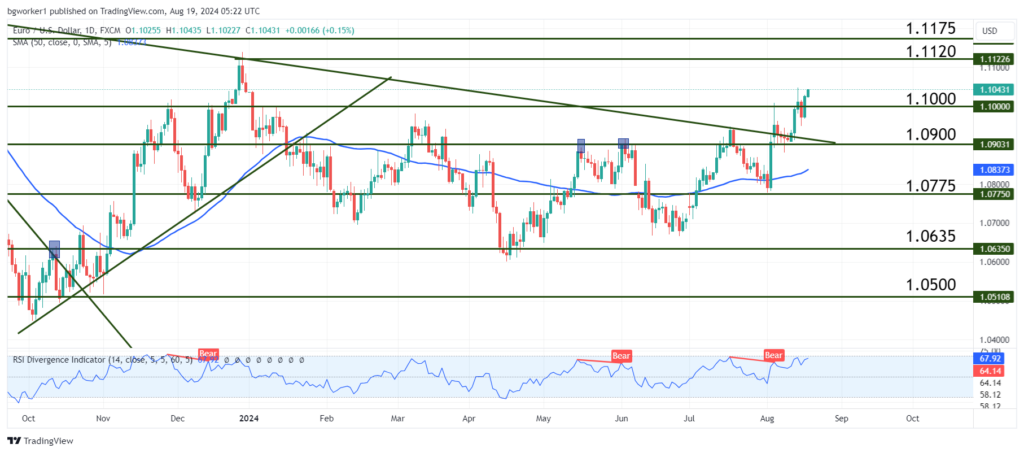Jackson Hole: Powell to Signal Rate Cut—But By How Much?
EUR/USD Closes Above 1.1000 for the First Time in 2024. Pullbacks Next?
U.S. inflation is on the right path as shown by last week’s CPI report that posted a reading of 2.9% year-on-year, lower than the anticipated 3.0%. However, the monthly figures accelerated from 0.1% to 0.2% for the Core version and from -0.1% to 0.2% for the headline CPI.
The US Dollar Index (DXY), which measures the USD against a basket of 6 currencies, dropped significantly last week and continued to drop Monday, currently trading at 102.068. The last time it reached this level was in January of this year.
Against the Euro, the greenback underperformed as well, allowing EUR/USD to close the week above 1.1000 for the first time since December 2023.
Market participants have fully priced in a rate cut in September. According to the CME FedWatch tool, there’s a 71.5% chance for a 25 bps cut, while the chance for a 50 bps cut is 28.5%. The Fed minutes and Fed Chair Powell’s speech at the Jackson Hole Symposium will offer clues about the extent of the rate cut.
Economic Calendar Highlights
The first major release of the week is scheduled for Wednesday at 6:00 pm GMT: the FOMC Meeting Minutes. This is a detailed record of the latest FOMC Meeting and contains details about the reasons that determined the latest rate vote.
Thursday morning, a bunch of Services and Manufacturing PMIs will be released for the French, German, and U.K. economies. Later in the day, at 1:45 pm GMT, the homologue indicators for the U.S. economy will come out. Also Thursday, the Jackson Hole Symposium will start.
Friday’s main event will be the speech delivered by Fed Chair Powell at the Jackson Hole Symposium. The topic will be economic outlook and according to consensus, he will likely confirm the rate cut for September. If that happens, we can expect to see increased volatility. The speech is scheduled for 2:00 pm GMT.
Technical Outlook – EUR/USD
In early August, the bulls attempted to break 1.1000 but it resulted in a swift drop to 1.0900. Last week, EUR/USD finally closed above 1.1000 and this time it looks like it’s a clean break. The looming rate cut is probably the biggest reason for US Dollar weakness. The European economy is far from a stellar performance, which means that EUR strength is not the main factor for the climb.
The RSI is approaching overbought, so we may see some pullbacks but the main bias is bullish and the next main target is the previous top at 1.1120. We will probably have a week where the price action will be mainly driven by the fundamental side, especially if forward guidance regarding the U.S. monetary policy is offered.
